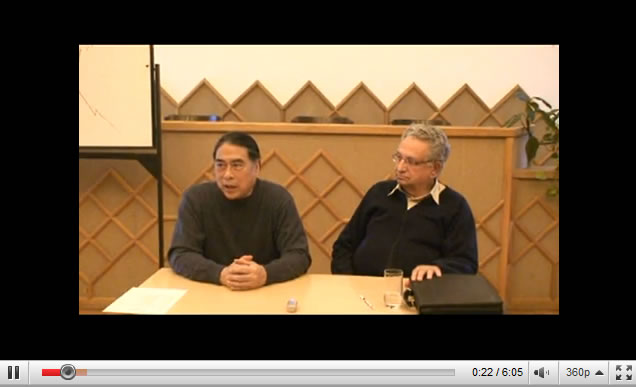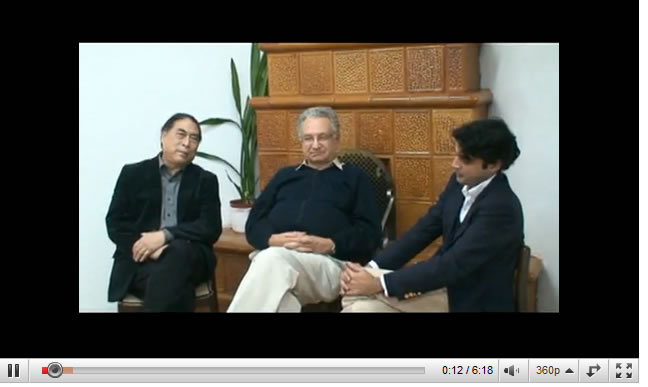Gold, Professor Fekete And The Economic Armageddon Signal
Economics / Great Depression II Apr 13, 2010 - 04:25 AM GMTBy: Darryl_R_Schoon
 When the end comes, it will be a surprise even to those who expect it
When the end comes, it will be a surprise even to those who expect it
When Professor Antal E. Fekete began lecturing on Austrian economics in Hungary in the spring of 2007, the global economy had not yet experienced the collapse which Austrian economist Ludwig von Mises had predicted over a half century before, to wit,
There is no means of avoiding the final collapse of a boom brought about by credit expansion. The alternative is only whether the crisis should come sooner as the result of voluntary abandonment of further credit expansion, or later as a final and total catastrophe of the currency system involved.
Human Action, a Treatise on Economics, Ludwig von Mises (Fox & Wilkes, 4th rev. ed., 1963)
A quarter century of uninterrupted and unprecedented credit expansion begun by the US in the 1980s, however, came to an abrupt halt months later in August 2007 when global credit markets froze, precipitating an economic crisis the severity of which surprised all except those who expected it.
Among those who foresaw the crisis was Peter Warburton. In 1999, Warburton warned in his extraordinary book, Debt & Delusion, that changes in our financial system masked deep maladjustments that would someday make themselves known, that rapidly rising valuations would readjust, perhaps violently, and that we were particularly blind in recognizing the dangers which confronted us.
Warburton was not an Austrian economist who believed in the inevitable collapse of excessive credit driven markets. Warburton instead believed that debt-based money and credit aggregates controlled by central bankers were critical components of modern functioning economies.
In an article in 2001, Warburton wrote:
We called ourselves international monetarists then and we had a model that determined the inflation rate from the growth of money stock per unit of output, with long and variable lags… We felt sure that if the authorities could regulate the growth of the money supply, all would be well.
He then added,
How wrong we were.
WARBURTON’S CONTRIBUTION
Warburton’s contribution to the current economic dialogue derives from his belief in that which he now critiques. Warburton’s blinding insights are those of one who was himself previously blind.
Warburton’s Debt & Delusion, published in 1999, is a seminal work explaining what went wrong and where. His explanation of the changed role of banks and government in the issuance of credit is uniquely insightful; and, whereas Austrian economics offers a wide-angle view of the present crisis, Warburton’s Debt & Delusion gives what only a jeweler’s loupe can provide, a close-up focus that explains and exposes the blind spots of those who still purport to see.
the leading economies..have fallen victim to a dangerous illusion, related to the anarchic development of global capital and credit markets. … the thesis is very straightforward: that both citizens and governments have become heavily addicted to borrowing and no longer care about the consequences.
Seen through Warburton’s eyes, the delusions of modern economists are many, such as central banking’s believed containment of inflation, what economists such as Paul Samuelson and Ben Bernanke call “the great moderation”, which is, in fact, but a communal delusion; a collective and fatal error the consequences of which have yet to be fully experienced.
PUBLISHING THE TRUTH
A THREAT TO THEIR KINGDOM
Published in 1999, the first printing of Debt & Delusion sold out, befitting a work of elegantly written prose and unique insights. In the book industry, it is expected that a sold out first printing is followed by a second and a third and so on until public demand is satisfied.
For those knowledgeable about book selling, the currently failing model is based on costly first time marketing and distribution efforts by publishers who hope their initial costs will be recouped. If so, publishers can then sell additional printings to a waiting audience. But although Debt & Delusion sold out, it was never reprinted by its original publisher.
Instead, Debt & Delusion was to share the fate of another book of significant monetary importance, The of Future of Money by Bernard Lietaer. Bernard Lietaer’s reputation in the world of money and economics is well-deserved. Retained by both nations and multi-national corporations to consult on issues of monetary importance, Lietaer was, in addition, once named the world’s top currency trader by Business Week.
As such, Lietaer is a respected financial figure and his criticism of today’s monetary system is not to be taken lightly. Lietaer’s criticisms, however, are far more fundamental than those of either Warburton or Austrian economists—Lietaer in The Future of Money directly targets the system of money itself and specifically the US dollar, warning among other things that:
..Unless precautions are taken, there is at least a 50-50 chance that the next five to ten years will see a dollar crisis that would amount to a global meltdown.
The Future of Money, Bernard Lietaer, Century/Random House 2001
Although written in English and published by Random House, the world's largest English language trade publisher, Lietaer’s book was never sold in the US: and, like Warburton’s book, monetarily significant with a sold-out first printing, a second printing was never forthcoming.
Perhaps coincidentally—or perhaps not—a book with the same title, The Future of Money, written by another author, Benjamin J. Cohen, was later published by Princeton University Press with instead a strongly positive message about the US dollar.
Today, a hardcover copy of Lietaer’s The Future of Money is available from resellers on amazon.com for $249.95 and softcovers for $180.91, a testimony to the still current popularity and demand for his book.
Peter Warburton’s Debt & Delusion also commanded prices in the $100 and $200 range for aftermarket copies; and, although the demand was evident for both books, for other, less evident, reasons, they were never reprinted by their original publishers.
In the East, Mao Tse-Tung had concluded that power comes out of the barrel of a gun. But, in the West, for 250 years power has come from the bankers’ issuance of debt-based paper money and the franchise for that power is not going to be easily relinquished—or its shortcomings and vulnerabilities readily allowed to be revealed.
THE ARMAGEDDON SIGNAL
At the Gold Standard Institute session in Hungary in March, Sandeep Jaitly explained the origins and intricacies of the calculating the basis and co-basis, the two elements he uses in anticipating movements in the price of gold.
It was Peter Warburton who had first directed Sandeep Jaitly to the writings of Professor Fekete and it was Professor Fekete who encouraged Mr. Jaitly to study the basis. Both the professor and Mr. Jaitly share a deep respect for the theories of Carl Menger, the Austrian economist; and, at the conference, Professor Fekete announced a curriculum where the ideas of Austrian economists such as Menger will be taught.
Mr. Jaitly believes there is no better signal than the basis for anticipating the eventual flight out of paper assets into gold—an event he believes will be predicted by the basis, i.e. the Armageddon signal, a sign that the tipping point has been reached. My interview with Mr. Jaitly on this subject can be viewed -
MONEY, POWER, ELITES & THE EURO
The euro is an attempt by European elites to imitate the 250 year-old Anglo-American franchise of global power derived from the ability to issue debt-based money from a central bank and parlay this into increased economic and political power. The intent was to return Europe to a position of power more equal to that of the US.
By the end of the 20th century, it was clear that the US dollar was increasingly vulnerable. Since 1971, the US dollar could no longer be converted to gold, giving Europe the opportunity to issue its own currency, the euro. But from its inception, the euro contained flaws which were ignored by the European elites in their determination to achieve their political ends.
In Debt & Delusion (in 1999), Peter Warburton questioned the efficacy of the eurozone’s goals:
…The determination of a political elite to bring the single European currency into being has swept aside all forms of opposition…However, the gravity of the commitment that these politicians have made on behalf of their electorates will take time to become fully apparent.
…They have been led to believe that their economic lives will become more straightforward and that a single currency will enhance the economic standing of Europe on the world stage…On the contrary, the political independence of the constituent countries is at stake in this bold venture…The ability and the desire of the EMU countries to abide by new fiscal rules must be seen in the light of past budgetary lapses and heavy net interest burdens. [bold, mine]
pp. 230, 233
The elites of the EMU countries, however, did want to hear about possible problems. Elites have agendas and arguments opposing those agendas are rarely given serious consideration.
While the European elites were correct that the Anglo-American empire was vulnerable; they were wrong in believing the euro would provide a meaningful alternative as the euro, like the dollar, would not be backed by gold.
It is now clear that US opposition to a gold-backed euro would have prevented its implementation. In The Future of Money, Lietaer refers to US opposition to any new global reserve currency. This is because the US dollar is the foundation of US power just as the British pound was the basis of the British empire.
The foundation of the Anglo-American franchise of global power was debt-based paper money backed by gold. But, in the 1930s, England could no longer maintain its gold backing; and the US was unable to do so after 1971, a process I describe in The Traveler’s Tale (2005), a story of how America lost its wealth in its pursuit of empire, a pursuit that would cost it far more than it would ever gain, see
http://www.drschoon.com/articles%5CTheTravelersTaleCanteburyTalesRedux.pdf
THE WEST’S WAR ON GOLD
After 1971 when gold was no longer anchored the currencies of the West, Western central banks embarked on a campaign to defend their now fiat paper currencies against any rise in the price of gold, oil and other commodities that would expose the declining value of their paper currencies.
Thus began the West’s war on gold, a war directed by the West’s central banks. In an article written in 2001, Peter Warburton expertly deconstructs and details what to most is still opaque, the reason why the gold market is manipulated by Western ruling elites.
Warburton’s article exposes why the US Commodity Futures Trading Commission last month chose to ignore charges that gold and silver markets are manipulated. The central banks (and the CFTC) are well aware of the manipulation; the reason being that central banks are responsible for the manipulation and Warburton explains why:
What we see at present is a battle between the central banks and the collapse of the financial system fought on two fronts. On one front, the central banks preside over the creation of additional liquidity for the financial system in order to hold back the tide of debt defaults that would otherwise occur. On the other, they incite investment banks and other willing parties to bet against a rise in the prices of gold, oil, base metals, soft commodities or anything else that might be deemed an indicator of inherent value. Their objective is to deprive the independent observer of any reliable benchmark against which to measure the eroding value, not only of the US dollar, but of all fiat currencies. Equally, their actions seek to deny the investor the opportunity to hedge against the fragility of the financial system by switching into a freely traded market for non-financial assets.
It is important to recognize that the central banks have found the battle on the second front much easier to fight than the first. Last November, I estimated the size of the gross stock of global debt instruments at $90 trillion for mid-2000. How much capital would it take to control the combined gold, oil and commodity markets? Probably, no more than $200bn, using derivatives. Moreover, it is not necessary for the central banks to fight the battle themselves, although central bank gold sales and gold leasing have certainly contributed to the cause. Most of the world’s large investment banks have over-traded their capital so flagrantly that if the central banks were to lose the fight on the first front, then their stock would be worthless. Because their fate is intertwined with that of the central banks, investment banks are willing participants in the battle against rising gold, oil and commodity prices.
Central banks, and particularly the US Federal Reserve, are deploying their heavy artillery in the battle against a systemic collapse. This has been their primary concern for at least seven years. Their immediate objectives are to prevent the private sector bond market from closing its doors to new or refinancing borrowers and to forestall a technical break in the Dow Jones Industrials. Keeping the bond markets open is absolutely vital at a time when corporate profitability is on the ropes. Keeping the equity index on an even keel is essential to protect the wealth of the household sector and to maintain the expectation of future gains. For as long as these objectives can be achieved, the value of the US dollar can also be stabilized in relation to other currencies, despite the extraordinary imbalances in external trade.
http://www.gata.org/node/8303,
WHY GOVERNMENTS HELP BANKS INSTEAD OF PEOPLE

When the global economy collapsed in 2008, governments rescued the banks, the very ones responsible for the collapse. This is because without the banks’ debt-based paper money, governments could not spend the vast amounts they do not really have.
Politicians seek power and bankers seek profit and their collusion is responsible for the present crisis. Do not be surprised at the current state of affairs, the motives of the participants are clear and so are the consequences.
These are exceptional times and while we are helpless to prevent what is about to happen, so, too, are bankers and politicians. They have brought this state of affairs upon themselves and for this we should be grateful—for without their demise we would be enslaved forever.
Peter Warburton’s Debt & Delusion is now available at amazon.com reissued by WorldMetaview Press. The price is $75. The truth is priceless.
Buy gold, buy silver, have faith.
By Darryl Robert Schoon
www.survivethecrisis.com
www.drschoon.com
blog www.posdev.net
About Darryl Robert Schoon
In college, I majored in political science with a focus on East Asia (B.A. University of California at Davis, 1966). My in-depth study of economics did not occur until much later.
In the 1990s, I became curious about the Great Depression and in the course of my study, I realized that most of my preconceptions about money and the economy were just that - preconceptions. I, like most others, did not really understand the nature of money and the economy. Now, I have some insights and answers about these critical matters.
In October 2005, Marshall Thurber, a close friend from law school convened The Positive Deviant Network (the PDN), a group of individuals whom Marshall believed to be "out-of-the-box" thinkers and I was asked to join. The PDN became a major catalyst in my writings on economic issues.
When I discovered others in the PDN shared my concerns about the US economy, I began writing down my thoughts. In March 2007 I presented my findings to the Positive Deviant Network in the form of an in-depth 148- page analysis, " How to Survive the Crisis and Prosper In The Process. "
The reception to my presentation, though controversial, generated a significant amount of interest; and in May 2007, "How To Survive The Crisis And Prosper In The Process" was made available at www.survivethecrisis.com and I began writing articles on economic issues.
The interest in the book and my writings has been gratifying. During its first two months, www.survivethecrisis.com was accessed by over 10,000 viewers from 93 countries. Clearly, we had struck a chord and www.drschoon.com , has been created to address this interest.
Darryl R Schoon Archive |
© 2005-2022 http://www.MarketOracle.co.uk - The Market Oracle is a FREE Daily Financial Markets Analysis & Forecasting online publication.





